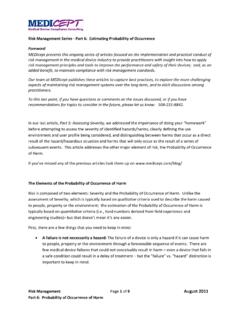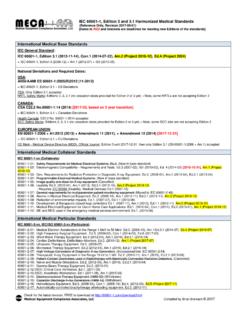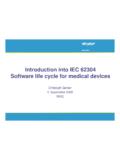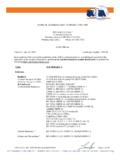Transcription of Risk Management Series - Part 5: Assessing Severity
1 Risk Management Page 1 of 10 July 2011 part 5: Severity Assessment Risk Management Series - part 5: Assessing Severity Foreword MEDI cept presents this ongoing Series of articles focused on the implementation and conduct of risk Management in the medical device industry to provide practitioners with insight into how to apply risk Management principles and tools to improve the performance and safety of their devices; and, as an added benefit, maintain compliance with risk Management standards. Our team at MEDI cept, publishes these articles to capture best practices, to explore the more challenging aspects of maintaining risk Management systems over the long term, and to elicit discussions among practitioners. To this last point, if you have questions or comments on the issues discussed, or if you have recommendations for topics to consider in the future, please let us know: 508-231-8842.
2 Our previous articles have focused on the role of risk Management in improving device safety, the importance of prioritizing risk Management activities, the use of Fault Tree Analysis (FTA), and how to transfer FTA results into FMEAs. In this article, we will begin to explore specific topics related to the conduct of FMEAs by addressing the challenge of Assessing the Severity of harm. If you ve missed any of the previous articles look them up on Risk Management : Assessing Severity One of the most challenging elements of risk analysis is the assignment of a Severity score to a particular hazard or failure mode. On the surface, assigning a Severity score seems pretty straight-forward: establish a set of criteria describing increasing levels of harm ( , from Negligible to Catastrophic ) and select the Severity level most appropriate for each hazard in your analysis.
3 Unfortunately, like most things, the devil is in the details. If you ve ever participated in the assignment of Severity scores in a risk analysis, the following discussion among Risk Analysis Team members may sound familiar: Facilitator: Alright, moving on to line 37, the harm is an electrical shock to the user due to improper grounding. Are there any recommendations for a Severity score? Engineering: That s not likely to happen: it ll be designed to 60601-1 standards. Facilitator: The Probability of Occurrence is a separate discussion. If it did occur, what is the Severity of the harm? Engineering: It s just 120 AC, I d say Minor, maybe Moderate. QA: But what if the user has a heart condition? Wouldn t that be the worst case? And if he or she had a heart attack and no one was around to help them it could be serious -- Certainly hospitalization and maybe even death.
4 Risk Management Page 2 of 10 July 2011 part 5: Severity Assessment Facilitator: Susan [the Clinician], could a 120 AC shock cause cardiac arrest? Clinician: I don t know if it s the most likely scenario, but it is possible. Facilitator: Well, the standard does require that we consider foreseeable sequences of events. QA: I agree, I think death is the worst case so it should be Catastrophic. It s best to be conservative. Facilitator: Okay, does everyone agree? All: Yes .. Sure .. OK .. Facilitator: Okay, the next one is where the device loses power during an operation. Since this is a life sustaining device I think this type of failure would be quite severe. Do you agree that the effect could be Catastrophic ? Clinician: I agree. If this failure occurs during the procedure, the patient would be at great risk of serious injury or death if backup equipment isn t available.
5 Facilitator: Are we agreed? All: Yes .. Yes .. Yes .. Independent Team Member: It seems like we have a lot of hazards that are rated Catastrophic, but some seem much worse to me than others Is this process really helpful? Facilitator: This is how the process works. The risks will be different once we assign Probabilities of Occurrence. Don t worry. Independent Team Member: Okay, but if everything is going to end in death, I don t see how we re going to be able to prioritize mitigations. Facilitator: Don t worry. I think you ll see how we do it once we get to that part of the process. Now for the next one: the user gets cut on a sharp corner of the device. I think we should consider the potential for infection, which if not treated promptly .. I think you see where this is going.
6 The hero of our story, the Independent Team Member, makes an important point: the objective of a risk analysis is to help the team make decisions about which hazards represent the greatest risks, and thus where risk reduction efforts should be focused. As a wise professor of mine once said, Information that doesn t help you make a decision has no value. If all of your risks fall into the high Severity region of your risk acceptability table (when, in fact, the harms and associated severities are Risk Management Page 3 of 10 July 2011 part 5: Severity Assessment quite different), the time and effort that your team spends in the conference room updating your FMEAs may not be as valuable as it is supposed to be. So what to do? .. Unfortunately, the guidance in ISO 149711 is not always helpful when discussing this challenge.
7 The discussion of Severity in Appendix D, Section is limited to one paragraph and one concluding sentence that make the following points: While Severity is, in reality, a continuum, the use of a discrete number of Severity levels simplifies the analysis. The manufacturer decides how many categories of Severity are needed and how they are to be defined, and each category should be explicitly defined. The category definitions should not include any element of probability. The Severity levels need to be chosen and justified by the manufacturer for a particular medical device under clearly defined conditions of use. In subsequent sections, the standard recommends that three to five levels are typically appropriate for both Severity and Probability of Occurrence (Section ) and offers the following example of qualitative Severity levels: Negligible: Inconvenience or temporary discomfort Minor: Results in temporary injury or impairment not requiring professional medical intervention Serious: Results in injury or impairment requiring professional medical intervention Critical: Results in permanent impairment or life-threatening injury Catastrophic: Results in Patient Death So far, this is all very helpful.
8 But then in Appendix E, they provide an example that directly demonstrates the challenge faced by our fictitious Risk Analysis Team. If you review the harms associated with the five example hazards in Table 1, you will see that they have one thing in common: Death. 1 ISO 14971:2007 Medical Devices Application of Risk Management to Medical Devices Risk Management Page 4 of 10 July 2011 part 5: Severity Assessment Table 1: Example from ISO 14971, Table It seems that all hazards may lead to death it s just that some may require a longer forseeable sequence of events to get there. The problem is that the standard is quite clear on the point that the Severity definitions should not include any element of probability (Section ).
9 So while it may be more likely for death to occur when a defibrillator battery fails, the Severity score for that hazard is the same as a hazard that could lead to a bacterial infection, which could also cause death. So how do we resolve this problem? At MEDI cept, we recommend a three-step process when Assessing Severity : 1. Do your Homework 2. Define your use scenario 3. Focus on direct effects Risk Management Page 5 of 10 July 2011 part 5: Severity Assessment Do Your Homework One of our primary recommendations to clients with regard to conducting risk analyses is to do their homework before jumping into detailed analyses. By homework we mean conducting research into the type of hazards and failures (and associated harms) that can occur as a result of the use of your device.
10 There are a variety of tools and approaches that your team can use to develop a strong understanding of likely hazards/failures/harms before beginning an analysis. A few of these include: ISO 14971:2007 Annex C and Table : The Annex C title, Questions that can be used to identify medical device characteristics that could impact on safety, pretty much says it all. This annex to the standard provides 34 questions that manufacturers can use to begin to identify potential safety issues associated with their device. Many manufacturers include the answers to these questions in their Risk Management File. The answers can help you to identify where to focus your risk assessment efforts. Table , Examples of Hazards, provides a list of generic hazards, which can be a very helpful, top-down tool for thinking about potential hazards.








